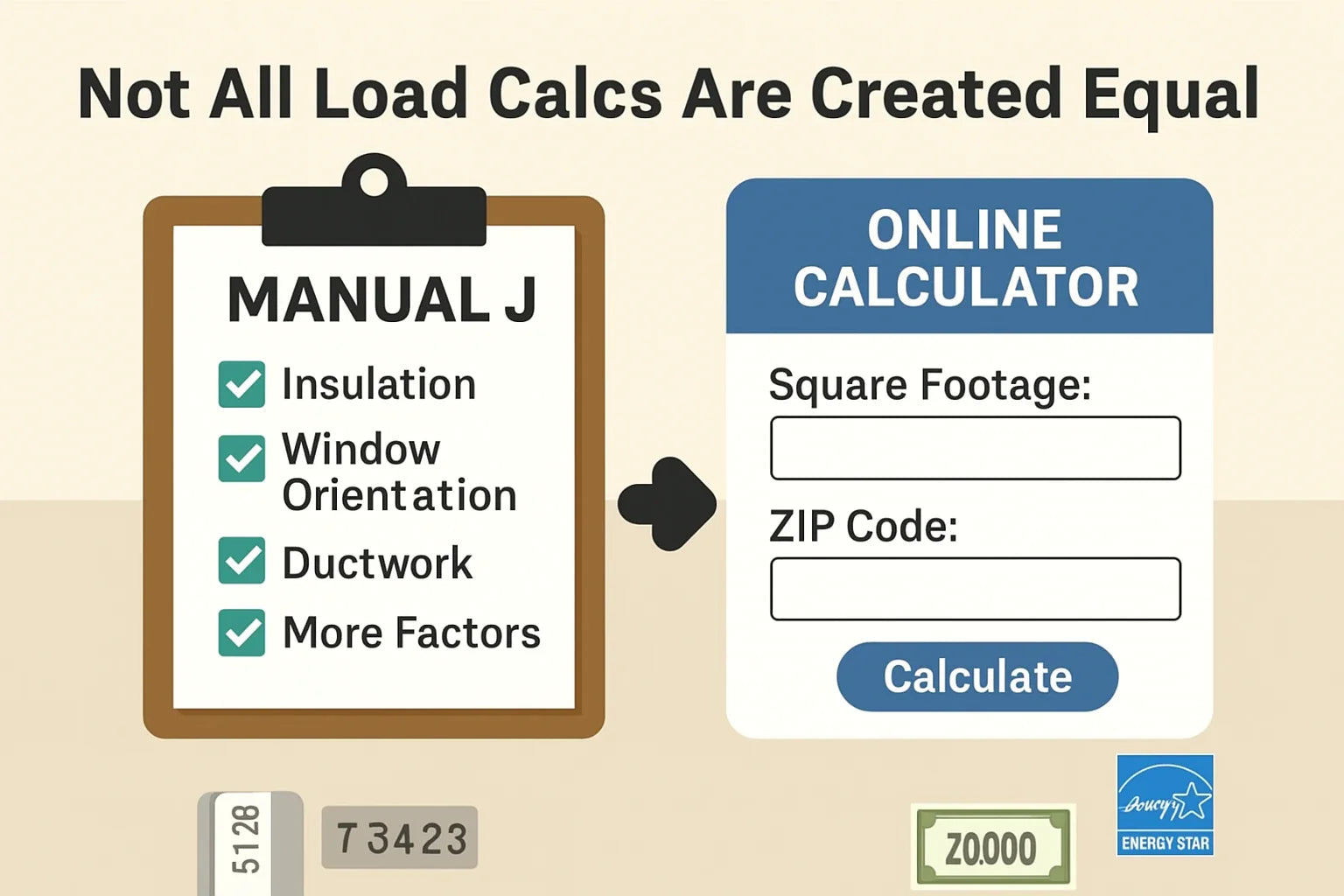Hi, I’m Alex Lane — your Home Comfort Advocate. I’ve spent 8 years in the HVAC field helping homeowners make smarter, safer, and more efficient choices for their comfort systems. One of the most common pitfalls I’ve seen? Homeowners relying too heavily on online HVAC load calculators to size their systems.
It sounds convenient—plug in a few numbers, get a BTU estimate, and start shopping. But the truth is, these tools can miss key details that make or break your system’s performance. An inaccurate estimate might lead to a unit that’s too big, too small, or just plain inefficient for your home.
In this guide, I’ll walk you through the pros and cons of using online load calculators, when they work, when they don’t, and how to avoid costly sizing mistakes from the start.
🔍 Want to understand HVAC sizing from the ground up? Start with our How to Size an HVAC System for Your Home guide. It covers all the factors calculators often miss.
What Is an HVAC Load Calculator?
An HVAC load calculator is a tool that estimates your home’s heating and cooling needs—usually in BTUs or tons—based on a few inputs like:
-
Square footage
-
Zip code or climate zone
-
Number of windows and doors
-
Insulation level
-
Occupancy and building type
These tools are commonly found on manufacturer websites like Mitsubishi Electric and cost estimator sites like Homewyse. They’re a fast and free way to get a ballpark figure for system sizing.
When Online HVAC Calculators Are Useful
⚡ Quick, Free, and Better Than Guesswork
If you're just starting to plan for an HVAC upgrade or build, an online load calculator can help you get in the right BTU range. It’s a huge step up from “1 ton per 500 square feet” rules-of-thumb that ignore insulation, climate, and window placement.
The Whole Building Design Guide emphasizes that HVAC systems must be carefully sized and selected to deliver maximum efficiency and indoor comfort. Even small miscalculations can lead to energy waste and subpar performance—especially in tightly sealed or high-efficiency homes.
🧾 Helpful for Budgeting and Comparing
These tools are also helpful for budget planning. By knowing whether your home likely needs a 2.5-ton or 3-ton unit, you can begin comparing prices, checking rebates, or estimating monthly energy use.
Why Load Calculators Can Be Misleading
🧮 Oversimplified Inputs
The downside? Most calculators only scratch the surface. They might ask for square footage and insulation level, but they often don’t account for:
-
Room-by-room load differences
-
Orientation and shading
-
Ceiling height and attic condition
-
Window glazing or air leakage
-
Ductwork design or losses
Two 2,000 sq. ft. homes in the same zip code could have very different HVAC needs depending on these details. A cookie-cutter calculator won't catch that.
The Department of Energy emphasizes that proper sizing requires analyzing heat gain and loss, not just square footage.
❌ Not a Substitute for Manual J
The gold standard in HVAC sizing is the Manual J load calculation—a professional method that uses detailed inputs to calculate the exact heating and cooling load for your home.
Manual J looks at:
-
Each room’s size, use, and insulation
-
Orientation and shading
-
Internal heat sources (appliances, people)
-
Local weather data
-
Ventilation and duct losses
Real-Life Example: When a Load Calculator Falls Short
A homeowner in Ohio used a popular online tool to size a system for their 1,800 sq. ft. colonial. The calculator recommended a 3.5-ton AC. But after installation, the system short-cycled constantly, failed to dehumidify, and raised their energy bills.
A contractor later performed a Manual J and found the correct load was 2.5 tons—due to tight insulation, shaded windows, and high-efficiency windows.
Moral of the story: The calculator overestimated by 1 ton. That mistake cost them over $1,500 in unnecessary system capacity and years of poor comfort.
How to Use a Load Calculator the Right Way
👍 Use It for Initial Planning
If you're still in the early research phase or planning a remodel, go ahead and use an online load calculator. It can help you:
-
Narrow down your options
-
Understand general size requirements
-
Estimate installation costs
Just make sure you treat the result as a rough guide, not a final spec.
👨🔧 Follow Up with a Manual J from a Pro
If you’re replacing or installing a new system, ask your HVAC contractor for a Manual J load calculation. Many include it as part of their estimate. If not, you can find certified pros through the ACCA Contractor Locator.
Signs of a Better Online Tool
If you’re going to use an HVAC load calculator, choose one that:
-
Asks about window size and orientation
-
Includes climate zone or ZIP code
-
Considers ceiling height
-
Asks about insulation, not just square footage
-
Offers a report, not just a BTU number
The more inputs required, the more likely you’re getting a useful estimate.
Final Thoughts
Online HVAC load calculators are a great first step—but they’re not the final word. Use them for initial research, cost comparisons, and education. But when it’s time to buy or install, trust the numbers from a Manual J calculation done by a pro.
It’s a small upfront investment that pays off in comfort, savings, and system longevity.
✅ Ready to dig deeper into smart sizing? Start here: How to Size an HVAC System for Your Home
🔁 Next up in the series: Why Sizing Matters More in Energy-Efficient Homes
Alex Lane
Your Home Comfort Advocate







